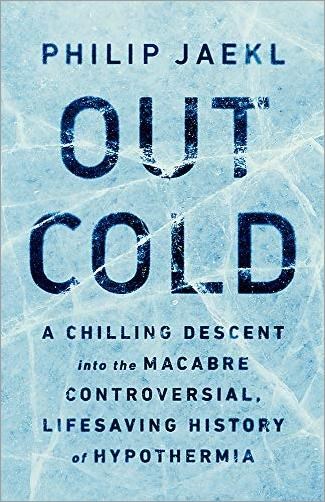Out Cold: A Chilling Descent into the Macabre, Controversial, Lifesaving History of Hypothermia
Phil Jaekl, Public Affairs, New York, 255 pages
There are probably few books dealing with this rather esoteric subject, perhaps the fact that the author grew up in Canada and now lives and works in Norway played a role in fostering an appreciation of cold.
Just what is cold? We know now that it is the absence of heat, which is a manifestation of the movement of molecules and atoms. The faster these molecules vibrate, the hotter the substance is, and vice versa. When the temperature reaches zero degrees Kelvin (named after a famous British physicist and equivalent to –273.15 ⁰C, or -459.67 ⁰F, for those who still use this outdated, antediluvian temperature scale) all movement ceases and the temperature cannot decrease any more.
It took a while to establish that humans, like mammals, maintain a stable body temperature, known as normothermia. The first known investigation of human body temperature was by Charles Blagden in 1775. To his astonishment he found that the body temperatures of people in a room heated to 127 ⁰C remained stable.
Jaekl gives a brief description of the interesting history of thermometer development, as well as how the concepts of heat and cold became established in science. This went hand in hand with investigations into the use of cold in medical treatments and Jaekl’s history of these devices and treatments make interesting reading.
Not all these treatments were humane, let alone effective. Even Philippe Pinel, a pioneer of humane treatment of patients with mental illness, wrote: “… one of the major principles of the psychological management of the insane is to break their will in a skilfully timed manner… a formidable show of terror should convince them that they are not free to pursue their impetuous wilfulness and that their only choice is to submit.”
Another rather gruesome example is a 1725 description by a dr. Patrick Blair, about a woman who wasn’t a “dutiful wife,” being “neglectful” and so on. She was “… lifted up by force… and fixt to the Chair in the bathing Tub.”
Cold water was then forcefully rained down on her for 30 minutes until she promised to mend her ways.
A week later this unfortunate woman was given another trial: “… adding a smaller pipe so that when the one let the water fall on top of her head the other squirted it in her face…”
This time it lasted for 60 minutes, the next one 90 minutes. “… I threatened her with the fourth Tryal, took her out of bed, had her stript, blindfolded and ready to be put in the Chair, when she being terrify’d… kneeled submissively….”
Research into the therapeutic applications of cold continued however, and in 1919 a medical student, Temple Fay, was asked a question which later occupied much of the rest of his life: why is metastatic cancer so rarely found below knees and elbows?
Years later he realized that it may have to do with temperature, and commenced a long series of experiments cooling patients with metastatic tumours, initially using localized techniques, progressing to whole-body cooling. Astonishingly, some patients were kept at body temperatures between 33 ⁰C (91 ⁰F) and 25 ⁰C (77 ⁰F) for up to eight consecutive days.
Initial results looked promising, although not spectacular, but then WW2 broke out and Fay’s research never gained traction afterwards. One reason was the widespread revulsion elicited by the horrendous research carried out by the Nazis, which involved putting prisoners in freezing water to find out how pilots who had been shot down over the sea could be resuscitated.
The next impetus for research into the medical application of cold came from a different direction. The space race was gaining momentum and with interstellar journeys regarded as a real possibility, the question arose how to keep astronauts alive for thousands of years. This, of course, would involve hibernation as well as hypothermia. Jaekl describes this research in an interesting chapter but as we all know now, to date this has not been tested.
From here it was a small step to move to the perennial quest for eternal life: cryonics, the storage of human remains, usually at -196 ⁰C (-320,8 ⁰F) in the hope that resurrection may be possible in the future.
Jaekl also writes about the possibility and problems of a head transplant, which, fortunately, has not taken place. Yet.
This is an extremely interesting book, filled as it is with historical vignettes, descriptions of more recent scientific research.
Serendipitously, the National Post published a good article on cryonics while I was reading the last chapter:
https://nationalpost.com/feature/cryopreservation-cryonics
The views and opinions expressed in this article are those of the author, and do not necessarily reflect the position of this publication.




